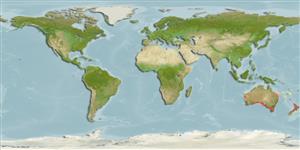Environment: milieu / climate zone / depth range / distribution range
экология
морской; солоноватоводный; пределы глубины 31 - 70 m (Ref. 58489). Subtropical; 20°S - 47°S, 109°E - 177°W (Ref. 189)
Southwest Pacific: Australia (from Queensland at about Cape Capricorn south to southern Tasmania; entire southern coast of Australia, except for Great Australian Bight, and north to Shark Bay, Western Australia), including Lord Howe Island and Norfolk Island; and New Zealand (most of the North Island and all but the southeast coast of the South Island).
Length at first maturity / Size / Вес / Возраст
Maturity: Lm 6.5, range 6 - 7 cm
Max length : 15.0 cm SL самец/пол неопределен; (Ref. 33832); common length : 12.0 cm SL самец/пол неопределен; (Ref. 9822); наибольший возраст (опубликованны данные): 6 годы (Ref. 6390)
колючие лучи спинного плавника (общее число) : 0; членистые (мягкие) лучи спинного плавника (общее число) : 13 - 18; колючие лучи анального плавника: 0; членистые (мягкие) лучи анального плавника: 17 - 19; позвонки: 40 - 48. Hardly differs from the European anchovy (E. encrasicolus) and can be identified from that description. For most of its range it is the only anchovy present, but in the extreme north it may overlap with species of Encrasicholina or Stolephorus, which have small needle-like scutes before the pelvic fins; species of Thryssa have compressed bodies and a keel of scutes along the belly.
Found mostly inshore: chiefly in bays, inlets and estuaries, sometimes in low salinities. Older individuals tend to move out to sea in winter and back in the spring. Forms compact schools much preyed upon by larger fishes, common dolphins and birds. Feeds on plankton. Spawns in inlets, bays and also estuaries, probably throughout the year but mainly in late spring to early autumn and especially about November to February. The eggs are ellipsoidal. Utilized as fish paste.
Spawns in inlets, bays and estuaries.
Whitehead, P.J.P., G.J. Nelson and T. Wongratana, 1988. FAO Species Catalogue. Vol. 7. Clupeoid fishes of the world (Suborder Clupeoidei). An annotated and illustrated catalogue of the herrings, sardines, pilchards, sprats, shads, anchovies and wolf-herrings. FAO Fish. Synop. 125(7/2):305-579. Rome: FAO. (Ref. 189)
Статус Красного Списка МСОП (Ref. 130435: Version 2024-2)
Угроза для людей
Harmless
Использование человеком
рыболовство: не имеет хозяйственного значения; наживка: usually
дополнительная информация
инструменты
Специальные отчеты
Скачать в формате XML
ресурсы в Интернет
Estimates based on models
Preferred temperature (Ref.
123201): 14.3 - 24, mean 17.1 °C (based on 72 cells).
Phylogenetic diversity index (Ref.
82804): PD
50 = 0.5020 [Uniqueness, from 0.5 = low to 2.0 = high].
Bayesian length-weight: a=0.00457 (0.00213 - 0.00980), b=3.12 (2.95 - 3.29), in cm total length, based on LWR estimates for this Genus-body shape (Ref.
93245).
Trophic level (Ref.
69278): 3.0 ±0.00 se; based on food items.
Generation time: 2.8 ( na - na) years. Estimated as median ln(3)/K based on 2
growth studies.
устойчивость к внешним воздействиям (Ref.
120179): высокий, минимальное время удвоения популяции до 15 месяцев (K=0.39; tm=1; tmax=6).
Fishing Vulnerability (Ref.
59153): Low to moderate vulnerability (25 of 100).
Nutrients (Ref.
124155): Calcium = 213 [100, 489] mg/100g; Iron = 1.3 [0.6, 3.0] mg/100g; Protein = 18.7 [17.5, 19.9] %; Omega3 = 0.838 [0.500, 1.399] g/100g; Selenium = 12.4 [5.6, 24.6] μg/100g; VitaminA = 19.9 [5.6, 69.1] μg/100g; Zinc = 1.47 [0.94, 2.25] mg/100g (wet weight);
